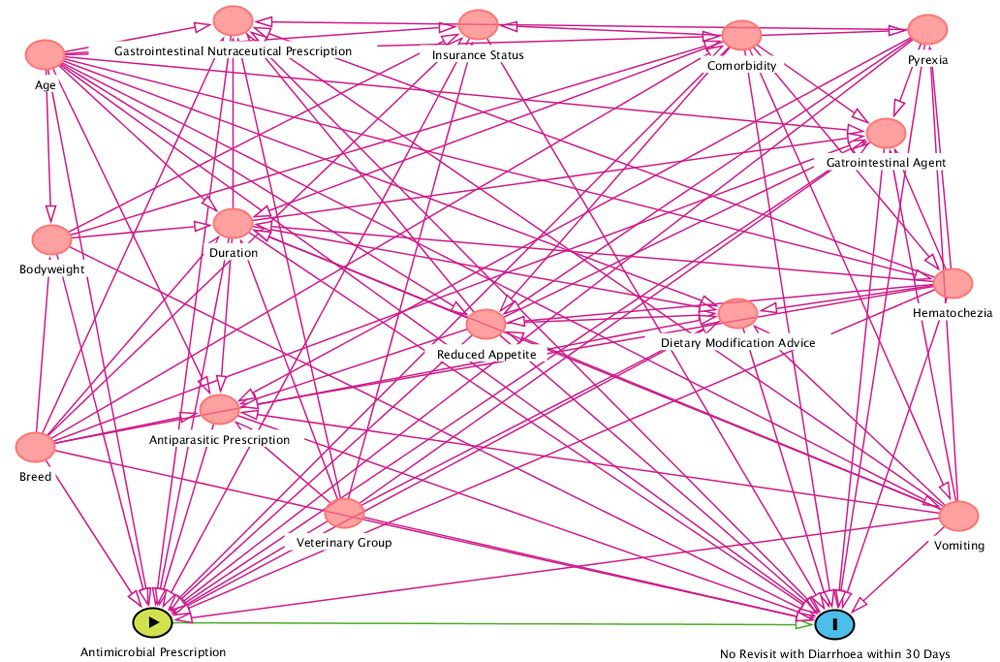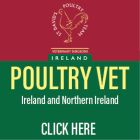The diarrhoea dilemma: are antimicrobials or gastrointestinal nutraceuticals really necessary?
Dr Camilla Pegram BVetMed MRes PhD MRCVS, Lecturer in Veterinary Epidemiology, Royal Veterinary College, University of London assesses the effectiveness of antimicrobials and gastrointestinal nutraceuticals in the treatment of acute, uncomplicated diarrhoea
Diarrhoea is the sixth most common disorder recorded in dogs annually in the UK (O’Neill et al., 2021), with most cases considered mild and self-limiting. Dietary indiscretion tends to be the main cause of diarrhoea, with dogs typically recovering well when given supportive care such as nutritional management and fluids.
Background
Antimicrobials should generally be reserved for cases where there’s a risk of sepsis, rather than as a go-to treatment (Allerton et al., 2021, Pegram et al., 2023, Jessen et al., 2024). Indeed, there is limited evidence that antimicrobials are any more effective than placebo or gastrointestinal nutraceuticals for treating acute, uncomplicated diarrhoea (Pegram et al., 2023). This echoes the British Small Animal Veterinary Association (BSAVA) “Protect me” guidelines, which state that dogs presenting with acute gastrointestinal signs, including dogs with haemorrhagic diarrhoea that are systemically well, do not require antimicrobial therapy (BSAVA, 2018). Likewise, the European antimicrobial stewardship guidelines (ASGs) do not recommend antimicrobials for treatment of acute diarrhoea in dogs (Allerton et al., 2021).
Nevertheless, over 50 per cent of dogs with acute, uncomplicated diarrhoea end up being prescribed antimicrobials. Metronidazole is the most commonly prescribed, followed by clavulanic acid potentiated amoxicillin (Singleton et al., 2019). This widespread use of antimicrobials is concerning, especially given the global issue of antimicrobial resistance (AMR) and the potential for pets to act as reservoirs for resistant bacteria or resistance genes that can affect humans (World Health Organization, 2018). Metronidazole, in particular, can have long-lasting effects on the gut microbiome, including bile acid dysfunction (Rogers-Smith, 2021).
For cases of acute diarrhoea, gastrointestinal nutraceuticals are often added to the treatment plan. Prebiotics, probiotics and synbiotics are frequently used either alone or alongside other therapies. However, recent systematic reviews suggest that these nutraceuticals may offer little to no benefit in the treatment of uncomplicated acute diarrhoea (Jensen and Bjørnvad, 2019, Scahill et al., 2024).
Measuring outcomes
The Veterinary Companion Animal Surveillance System (VetCompass) is a research programme that collects and analyses anonymised clinical data from veterinary practices. Started by the Royal Veterinary College (RVC) in the UK, VetCompass has expanded internationally, providing a comprehensive picture of disease management in everyday settings. The data collected for the acute, uncomplicated diarrhoea study (discussed below) came directly from primary-care veterinary clinics, reflecting real-world scenarios.
This provides a more accurate picture of disease management and outcomes compared to controlled or referral studies that might not capture everyday veterinary practice. VetCompass harnesses the power of large datasets and real-world evidence, enhancing understanding of animal health, which can ultimately result in the overall improved health and welfare of animals (RVC, 2023).
While randomised controlled trials (RCTs) are still considered the gold standard for determining treatment effects, they aren’t always practical _ or ethical _ in a clinical setting. That’s where VetCompass’s use of ‘target trial emulation’ comes into play. This novel approach lets researchers mimic the conditions of an RCT using existing data from routine veterinary records, which means we can draw conclusions on real-world treatment effects without having to rely solely on traditional trials (Pegram et al., 2023, Pegram et al., 2024a, Pegram et al., 2024b).
One recent VetCompass study used this ‘target trial emulation’ method to separately evaluate two common management strategies for acute diarrhoea in dogs: whether to prescribe antimicrobials or not, and whether to prescribe gastrointestinal nutraceuticals or not. The study looked at two outcomes: whether the diarrhoea resolved within 30 days without a revisit, and the time to any escalation of treatment i.e., further prescription of the same treatment or a different treatment (Pegram et al., 2023). Given the high rates of antimicrobial prescription within treatment plans for acute diarrhoea in dogs (Singleton et al., 2019) and growing concerns over AMR (World Health Organization, 2018), this study provided causal evidence to guide prescribing practices by veterinary professionals.
VetCompass study summary
In this study, we explored how antimicrobial and gastrointestinal nutraceutical prescriptions impact dogs with acute, uncomplicated diarrhoea by using causal inference methods to analyse data from a random sample of 894 dogs, aged between three months and 10 years. This approach aimed to replicate a randomised clinical trial. To guide our analysis, we created a causal diagram (also called a directed acyclic graph, or DAG) that laid out our understanding of the possible causal relationships at play.

Figure 1: Directed acyclic graph (DAG) illustrating our understanding, based on current evidence and expert opinion, of how prescribing antimicrobials for acute diarrhoea in dogs may affect clinical resolution. The same causal structure was believed to apply with time to treatment escalation as the outcome of interest. Similarly, the same causal structure was believed to apply when gastrointestinal nutraceutical prescription replaced antimicrobial prescription as the treatment of interest.
This helped us to identify the key factors we needed to account for during the study. So, we collected data on a variety of factors: age, breed, bodyweight, insurance status, comorbidities, presence of vomiting, reduced appetite, haematochezia, pyrexia, diarrhoea duration, any additional treatments prescribed, and veterinary group (as shown in Figure 1). By doing so, we aimed to build a comprehensive picture of how these variables might interact with each other and influence the treatment outcomes.
Balancing the treatment groups of the study for variables included in the DAG, the outcomes for dogs prescribed antimicrobials or gastrointestinal nutraceuticals were separately compared to those not prescribed antimicrobials or gastrointestinal nutraceuticals. The antimicrobial “trial emulation” included 355 dogs (39.7 per cent) that were prescribed antimicrobials and 539 dogs (60.3 per cent) that weren’t prescribed antimicrobials at the initial visit for acute diarrhoea. The gastrointestinal nutraceutical “trial emulation” included 597 dogs (66.8 per cent) prescribed gastrointestinal nutraceuticals and 297 dogs (33.2 per cent) not prescribed these products at first presentation.
It’s important to note that many of these dogs might have been prescribed other treatments as well, such as antiparasitics. To ensure that these additional treatments didn’t skew the results, we included them as “adjustment factors,” as shown in the DAG in Figure 1. The light red nodes represent confounding variables, i.e., variables affecting both the exposure and the outcome. These variables were then adjusted for in the analysis in the Figure 1 caption. The results showed that antimicrobial prescription at first presentation of acute diarrhoea in dogs, compared with no antimicrobial prescription, did not cause a significant change (i.e., neither an increase or decrease) in “clinical resolution” (which was defined as no revisit with ongoing diarrhoea within 30 days of first presentation). Dogs prescribed antimicrobials had a clinical resolution rate of 88.3 per cent, compared to 87.9 per cent for dogs not prescribed antimicrobials. This equates to a negligible risk difference of just 0.4 per cent (95 per cent CI: -4.5 per cent to 5.3 per cent). Additionally, when we looked at the likelihood of treatment escalation, there was no meaningful difference either. The chance of escalation within 30 days was 7.5 per cent for dogs prescribed antimicrobials and 7.7 per cent for those not prescribed antimicrobials, with a risk difference of 0.2 per cent (95 per cent CI: -3.9 per cent to 3.9 per cent). In short, our results show no clear benefit of antimicrobial prescription for acute diarrhoea.
For gastrointestinal nutraceuticals, we similarly observed no significant effect on clinical resolution. Specifically, the likelihood of clinical resolution in dogs prescribed gastrointestinal nutraceuticals was 88.2 per cent compared with 88.0 per cent in dogs not prescribed gastrointestinal nutraceuticals (resulting in a minor risk difference of 0.2 per cent, 95 per cent CI -4.5 per cent to 5.0 per cent). When we evaluated time to any treatment escalation, there was a slight increase in treatment escalation after day 10 for dogs prescribed gastrointestinal nutraceuticals. However, although significant, the difference in probability was minor.
Specifically, the probability of a treatment escalation by 30 days was 8.8 per cent in dogs prescribed gastrointestinal nutraceuticals and 5.3 per cent in dogs not prescribed gastrointestinal nutraceuticals (resulting in a risk difference of 3.5 per cent, 95 per cent CI -7.0 per cent to -0.4 per cent). It was reasoned that this might indicate that owners of dogs prescribed gastrointestinal nutraceuticals at first presentation exhibit health-seeking behaviour and are more invested in a clinical response.
Overall, the majority of dogs did not have a revisit for the diarrhoea episode, or a treatment escalation, whether they were prescribed antimicrobials or gastrointestinal nutraceuticals at first presentation or not. These findings support the recommendation to restrict the use of antimicrobials for acute diarrhoea in dogs within the veterinary profession. Knowing that the outcome will be the same without antibiotics should reassure veterinarians to adopt this approach consistently. While there is currently no evidence that gastrointestinal nutraceuticals have a negative impact in the treatment of acute, uncomplicated diarrhoea, our study found no clear evidence of a benefit in their use.
This highlights the importance of reflecting on whether such prescriptions are indeed necessary. Additionally, this study demonstrated the successful application of the “target trial emulation” framework to veterinary observational data, allowing determination of causal effects rather than being limited to associations. This is a promising step forward for making more informed, evidence-based treatment decisions in veterinary practice.
The full study is available open access:
https://doi.org/10.1371/journal.pone.0291057
An accompanying research infographic is available at:
ALLERTON, F., PRIOR, C., BAGCIGIL, A. F., BROENS, E., CALLENS, B., DAMBORG, P., DEWULF, J., FILIPPITZI, M.-E., CARMO, L. P., GÓMEZ-RAJA, J., HARPAZ, E., MATEUS, A., NOLFF, M., PHYTHIAN, C. J., TIMOFTE, D., ZENDRI, F. & JESSEN, L. R. 2021. Overview and Evaluation of Existing Guidelines for Rational Antimicrobial Use in Small-Animal Veterinary Practice in Europe. Antibiotics, 10, 409.
BSAVA 2018. BSAVA/SAMSoc Guide to responsible use of antibacterials: protect me, British Small Animal Veterinary Association.
JENSEN, A. P. & BJØRNVAD, C. R. 2019. Clinical effect of probiotics in prevention or treatment of gastrointestinal disease in dogs: A systematic review. J Vet Intern Med, 33, 1849-1864.
JESSEN, L. R., WERNER, M., SINGLETON, D., PRIOR, C., FOROUTAN, F., FERRAN, A. A., ARENAS, C., R. BJØRNVAD, C., LAVY, E., ALLERTON, F., ALLENSBACH, K., GUARDABASSI, L., UNTERER, S., BODNÁROVÁ, T., WINDAHL, U., BRENNAN, M. L., WEESE, J. S. & SCAHILL, K. 2024. European Network for Optimization of Veterinary Antimicrobial Therapy (ENOVAT) guidelines for antimicrobial use in canine acute diarrhoea. The Veterinary Journal, 307, 106208.
O’NEILL, D. G., JAMES, H., BRODBELT, D. C., CHURCH, D. B. & PEGRAM, C. 2021. Prevalence of commonly diagnosed disorders in UK dogs under primary veterinary care: results and applications. BMC Veterinary Research, 17, 1-14.
PEGRAM, C., DIAZ-ORDAZ, K., BRODBELT, D. C., CHANG, Y.-M., VON HEKKEL, A. F., WU, C.-H., CHURCH, D. B. & O’NEILL, D. G. 2024a. Target Trial Emulation: Does surgical versus non-surgical management of cranial cruciate ligament rupture in dogs cause different outcomes? Preventive Veterinary Medicine, 106165.
PEGRAM, C., DIAZ-ORDAZ, K., BRODBELT, D. C., CHANG, Y. M., HALL, J. L., CHURCH, D. B. & O’NEILL, D. G. 2024b. Later-age neutering causes lower risk of early-onset urinary incontinence than early neutering-a VetCompass target trial emulation study. PLoS One, 19, e0305526.
PEGRAM, C., DIAZ-ORDAZ, K., BRODBELT, D. C., CHANG, Y. M., TAYLER, S., ALLERTON, F., PRISK, L., CHURCH, D. B. & O’NEILL, D. G. 2023. Target trial emulation: Do antimicrobials or gastrointestinal nutraceuticals prescribed at first presentation for acute diarrhoea cause a better clinical outcome in dogs under primary veterinary care in the UK? PLoS One, 18, e0291057.
ROGERS-SMITH, E. 2021. The use of metronidazole in adult dogs with acute onset, uncomplicated, diarrhoea. Veterinary Evidence, 6.
RVC. 2023. VetCompass overview [Online]. Available: https://www.rvc.ac.uk/vetcompass/about [Accessed 21/09/2023].
SCAHILL, K., JESSEN, L. R., PRIOR, C., SINGLETON, D., FOROUTAN, F., FERRAN, A. A., ARENAS, C., BJØRNVAD, C. R., LAVY, E., ALLERTON, F., WEESE, J. S., ALLENSPACH, K., GUARDABASSI, L., UNTERER, S., BODNÁROVÁ, T., WINDAHL, U., BRENNAN, M. L. & WERNER, M. 2024. Efficacy of antimicrobial and nutraceutical treatment for canine acute diarrhoea: A systematic review and meta-analysis for European Network for Optimization of Antimicrobial Therapy (ENOVAT) guidelines. The Veterinary Journal, 303, 106054.
SINGLETON, D. A., NOBLE, P., SÁNCHEZ-VIZCAÍNO, F., DAWSON, S., PINCHBECK, G. L., WILLIAMS, N. J., RADFORD, A. D. & JONES, P. H. 2019. Pharmaceutical prescription in canine acute diarrhoea: a longitudinal electronic health record analysis of first opinion veterinary practices. Frontiers in veterinary science, 218.
WORLD HEALTH ORGANIZATION 2018. Global antimicrobial resistance surveillance system (GLASS) report: early implementation 2017-2018.
1. Where does diarrhoea rank in the most common disorders diagnosed in dogs annually in the UK?
A. First
B. Third
C. Sixth
D. Tenth
2. According to the BSAVA “PROTECT ME” guidelines, antimicrobials are only indicated for:
A. Acute diarrhoea with signs of sepsis
B. Acute haemorrhagic diarrhoea syndrome
C. Campylobacter, Salmonella, Clostridium perfringens or C. difficile infections
D. Acute vomiting and diarrhoea
3. Based on the random sample of acute, uncomplicated diarrhoea cases in the VetCompass target trial: What percentage of dogs were prescribed antimicrobials at first presentation of diarrhoea?
A. 12.4%
B. 26.7%
C. 39.7%
D. 53.6%
4. True or false: Prescribing antimicrobials at the first presentation of diarrhoea in dogs caused a significant improvement in clinical resolution compared to not prescribing antimicrobials.
A. True
B. False
5. True or false: There was no significant difference in clinical resolution between dogs prescribed gastrointestinal nutraceuticals and dogs not prescribed gastrointestinal nutraceuticals at first presentation of diarrhoea.
A. True
B. False
ANSWERS: 1C; 2A; 3C; 4B; 5A.
















